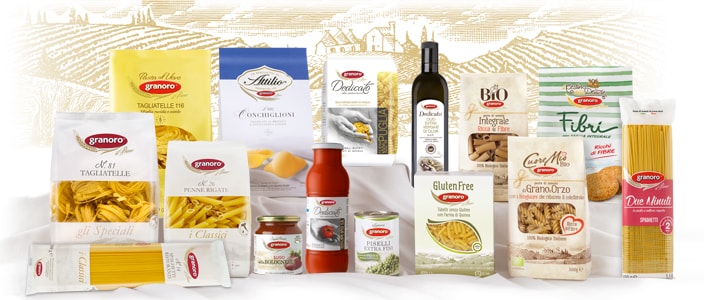-
According to the Decree of the President of the Republic No. 187 dated 9 February 2001, which in Italy regulates the production and sale of pasta products, special pasta is defined as that produced from semolina and containing permitted additional ingredients such as vegetables (spinach and tomato), malt or gluten and various fillings (vegetables, meat, cheese, eggs, fish and mushrooms).Special pasta must be sold with the description “durum wheat semolina pasta”, followed by the list of added ingredients.
-
Egg pasta is a special pasta made from a dough that, in addition to semolina and water, also contains at least four whole hen’s eggs, without the shell, with an overall weight of no less than 200 g of egg (equal to four eggs) per 1 kg of semolina.As egg is an ingredient that appears in the product sales description, in accordance with Circular No. 165 dated 31/03/2000, the label must also include the QUID quantitative ingredient declaration, in this case the amount of egg contained in the pasta. The QUID is expressed as a percentage based on the dough to which the eggs were added and is for four whole eggs, equal to 200 g of liquid egg, which is equal to 19.36%.The eggs in the dough may be substituted with an equal amount of liquid egg product, made exclusively from whole hen’s eggs, in compliance with the provisions set forth in Legislative Decree 65 dated 4 February 1993.Special egg pasta is sold in packaging marked solely with the description “egg pasta”.
-
Egg products are all types of egg without the shell and membrane, that is to say yolks, whites and a mixture of whites and yolks, with the possible addition of some additives.They are essentially practical, semi-processed substances produced from Class A and B eggs, sold in liquid, concentrated, powder, crystallised, frozen, deep frozen and coagulated form.The range of egg products available on the market is very wide and each of the products has functional characteristics designed to meet specific needs. Thanks to their practical nature and low cost, their use is often preferred over the use of traditional eggs for the production of doughs and in addition to their use in the production of foodstuffs, they may also be used for direct human consumption.
-
For the production of Granoro Egg Pasta, we make the dough using good quality semolina and four eggs per kg (QUID 19.36%), or more than five per kg if the dough is for the Sfoglia Antica range (QUID 26.53%).The eggs used to make Granoro Egg Pasta are fresh, Class A eggs, shelled, pasteurised and originating from Italian egg producers and from hens fed exclusively with natural chicken feed.
-
The egg class is a primary quality index attributed according to freshness and there are two categories, A and B.Class A eggs are intended for direct consumption, as such sales to consumers are authorised if all of the requirements set forth in the regulations in force governing said class have been met. Class A Extra very fresh eggs, not treated or refrigerated, with an air chamber of no more than 4 mm, which can be used up to the 7th day after packaging or the 9th day after laying; after this period the eggs may only be sold as Class A (they can no longer be classed as Extra); Class A fresh eggs, not treated or refrigerated, with an air chamber of no more than 6 mm; recommended sell by date, or the last date on which the eggs can be sold to a consumer (optional), calculated at 21 days from the date of laying and obtained by subtracting 7 days from the minimum duration date (28 days), considered to be an additional period for consumption by the consumer.The European Regulation prohibits the direct sale of Class B eggs to consumers; they can only be sold to food processing industries (e.g. companies producing confectionery, fresh pasta, etc) or non-food industries. Class B includes eggs that do not meet the requirements set forth for Class A eggs. They may only be sold to industrial companies within the food industry as defined in Article 6 of Directive 89/437/EEC or to the non-food industry.They are eggs that are two to three weeks old (air chamber of between 6 and 9 mm), untreated and unrefrigerated.They may also be eggs that have been downgraded or are of second-best quality, intended for transformation into egg products or use in the non-food industry. Their packaging is clearly marked to indicate their intended use.
-
Pasteurisation is a heat treatment applied to some foods to minimise the health risks posed by heat-sensitive pathogenic microorganisms.Pasteurisation is required in accordance with Legislative Decree 65/1993, which governs the use of egg products, not as a conservation treatment but as a compulsory health and hygiene requirement. The treatment is performed at temperatures that do not alter the sensory and nutritional characteristics of the egg product.
-
No, special egg pasta and standard pasta are two different products, each one distinguished by their own, incomparable quality markers.Durum wheat semolina pasta has a high energy value, thanks to the high starch content, a good protein content, is easy to digest and has a low fat content. The addition of eggs as an ingredient raises the biological protein value, increases the calcium, iron and phosphorous content, increases the lipids and raises the Vitamin B1 and A content. Egg is an important ingredient that gives products special characteristics. The two parts that make up an egg, the yolk and white, have different compositions that interact with the gluten protein contained in durum wheat semolina, strengthening the pasta’s protein network.
-
Yes. Special egg pasta has a higher nutritional value than standard pasta thanks to the presence of egg, added to the dough as an additional ingredient.The addition of eggs as an ingredient raises the biological protein value, increases the calcium, iron and phosphorous content, increases the lipids and raises the Vitamin B1 and A content. Eggs also provide a considerable amount of good quality complete proteins containing all of the amino acids essential for human beings and many nutritional elements.Looking at the lipid composition, eggs are very rich in lecithins and in general phospholipids, which offer considerable health and functional properties. In addition, although the fats contained in eggs are of animal origin, they are mainly composed of monounsaturated and polyunsaturated fats, which are considered beneficial to the organism. Eggs, especially the yolk, are rich in mineral salts, specifically iron, phosphorous and calcium and also contain a good amount of liposoluble and B vitamins. Eggs are also one of the few foods to contain Vitamin D, essential for the growth and health of bones. The yolk also contains a high concentration of carotenoids, pigments with a typical orange-red colour, which is also transferred to the pasta.
-
Granoro egg pasta is available in the following ranges:1. Small egg pasta shapes including Farfalline, Filini, Funghetti, Grattini, Grattoni and Quadrucci, purposely designed to cook in just a few minutes, which prevents alteration of their nutritional properties. They are recommended for use in thick and thin soups or with vegetable or meat stock;2. Nidi, made from Tagliolini, Fettuccine and Tagliatelle pasta, which have a short cooking time, a warm yellow colour, like the natural colour of eggs, and are made from thin, porous sheets of pasta, just like homemade pasta;3. Lasagne, consisting of rough, porous sheets of pasta, which are easy to prepare as you just add the sauce and place straight in the oven (without precooking);4. Sfoglia Antica, a particularly fine range of pasta as it is made from carefully selected semolina with the addition of more than 5 eggs per kg. Made from rough, thin sheets of pasta, just like those drawn by hand, it is available in two types: Pappardelle and Rustiche. It is packaged in elegant cardboard boxes to protect it from breakage, ensuring it remains intact.
-
Recognising good quality egg pasta is simple! Just look for these signs:1. The raw material: the best quality egg pasta is made using only durum wheat semolina and fresh, Class A eggs;2. Consistency: after cooking, egg pasta must have a good consistency, must not clump or stick together, should remain well separated on the plate and be elastic to the bite;3. Colour: good quality egg pasta will have an even, yellow colour, a bit stronger than normal pasta, but not excessively so, as that could indicate the use of chicken feed enriched with synthetic (artificial) beta carotene;4. Smell: good egg pasta will have an intense aroma, due to the presence of egg in the dough, which should be as pleasant and natural as fresh eggs, both before and after cooking;5. Flavour: eggs enrich the flavour of the pasta, giving it a slightly sweet taste.

 Italiano
Italiano
 English
English
 Français
Français
 Deutsch
Deutsch
 Español
Español
 Português
Português
 Japanese
Japanese
 русский
русский

 中國
中國




